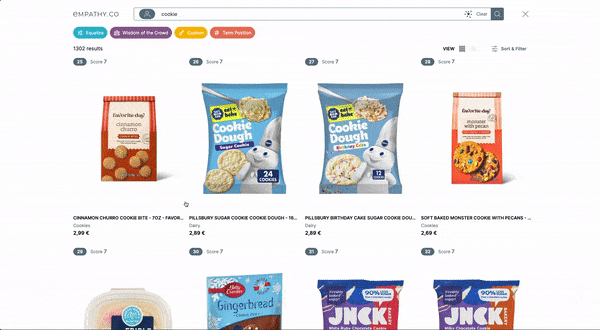Getting Smart with Special Dates
Getting Smart with Special Dates
With the World Cup and accompanying heatwave now a distant memory and summer clothes long buried at the back of the wardrobe, the work really begins for brands and retailers.
The last few months of the year can bear plenty of fruit, as consumers look to special dates and events such as Black Friday later this week, Christmas and the New Year sales as a chance to capitalise on bargains and a season of spending.
 While contemporary consumers want speed and convenience (not least during this busy shopping period), they also want to feel important, understood and appreciated. Experiences, particularly online, are now as important – if not more so – than the products themselves, with the requisite that these should be personalised, outstanding and irresistible. Today’s retailers need to make people feel special and create experiences that are individual, that generate emotion, and make customers feel good and connected to a brand.
While contemporary consumers want speed and convenience (not least during this busy shopping period), they also want to feel important, understood and appreciated. Experiences, particularly online, are now as important – if not more so – than the products themselves, with the requisite that these should be personalised, outstanding and irresistible. Today’s retailers need to make people feel special and create experiences that are individual, that generate emotion, and make customers feel good and connected to a brand.
But how can retailers do this? How can they offer tailored experiences to thousands, sometimes millions, of remote customers? How can they design their online shops with the individual at the centre while also creating digital experiences that are aligned with, and unique to, their brand values and narrative?
The secret is through developing a better understanding of their customers. After all, how can a brand really create a personalised experience without knowing what their clients want, why they want it and when? One method of doing this is by analysing search and browse data, an incredibly valuable asset and one often overlooked and under-exploited by online retailers, which can reveal important trends in consumer behaviours around key periods such as those of retail special dates.
Retail Special Dates are distinct days or periods when consumers demonstrate different and singular characteristics, displaying common attributes and specific shopping patterns. For example, they may exhibit a higher commitment to purchase but not have a clear idea of what they’re looking for. These are periods that can be some of the busiest shopping days of the year for retailers, generating high traffic, high buying intent as well as a high emotional sentiment for consumers.
Understanding the different types of Special Dates and the behaviours and patterns they produce can help retailers to anticipate and predict customer requirements, forecast trends and to detect and capitalize on opportunities. It allows merchandisers and product managers to plan stock levels and stores to make more informed decisions to enhance the customer journey while creating unique, more personalised digital brand experiences designed around the specific attributes of these shoppers.
With the above in mind, there are three different categories of special dates that I’ll explore here; sales and promotional periods, branded special dates, and gifting days. Each have their own unique qualities, advantages and characteristics, therefore needing to be treated in different ways. Let’s go through them one by one:
Sales and Promotional Periods
Black Friday is probably the biggest and best example of this, but of course, Boxing Day, Summer Sales and Back to School all fall under this category.
The Sales Season is a pretty hectic period in retail. There is a huge volume of purchases that take place in a reduced amount of time, ranging from hours to weeks. Shoppers go crazy, trying to find not only the things they need or want, but also looking for the best discounts.
 These are dates when shoppers often demonstrate both a high purchase and a high findability intent, having a pretty clear idea of what they want and an urgency to buy it before the item goes out of stock.
These are dates when shoppers often demonstrate both a high purchase and a high findability intent, having a pretty clear idea of what they want and an urgency to buy it before the item goes out of stock.
This means they rely heavily on the search box and expect to find and buy what they’re looking for quickly. That’s why the use of search-as-you-type suggestions, for example, is crucial as a means to save typing time, even if the search term is misspelled or maybe a SKU or ISBN number is used. During these periods, the use of search is key; if the user has a bad experience during their visit, they will not only not make a purchase but may also never come back.
Branded Special Dates
Examples of branded special dates include new capsule collection launches which can also align to external calendars, for example a festival season range in the UK, a new swimwear collection in the build-up to summer or perhaps pure brand specific dates. Retailers may even choose to create a micro-site to launch, for example, the latest mobile or TV set.
 During these periods, consumers demonstrate both a low findability and low purchase intent. They may be interested in learning about new items but have no pre-conceived need, no specific search focus and no particular mandate to buy.
During these periods, consumers demonstrate both a low findability and low purchase intent. They may be interested in learning about new items but have no pre-conceived need, no specific search focus and no particular mandate to buy.
On such dates, it’s important that online stores focus on the experience, placing a big spotlight on entertainment and the “wow factor”, creating moments that engender desire through cool browsing and narrative micro-iterations. This is a discovery experience that should be personalised, extremely cool and well-designed to be inspirational and trigger buying intent.
Gifting Days
These days include Valentine’s Day, Mother’s Day, Father’s Day, Easter and Christmas. These are dates when shoppers know they need to buy something but they may not know exactly what it is they’re looking for. On these days there is a high purchase intent that also relies on a high discovery component, where shoppers hope for inspiration rather than necessarily searching for a specific item.
 They are occasions that, especially for specific retailers, can be one of the busiest and most important days of the year driving millions of sales worldwide. For example, a chocolate specialist at Easter, a florist on Mother’s Day or a bookseller on World Book Day.
They are occasions that, especially for specific retailers, can be one of the busiest and most important days of the year driving millions of sales worldwide. For example, a chocolate specialist at Easter, a florist on Mother’s Day or a bookseller on World Book Day.
This means it’s especially important to understand shoppers’ intent and characteristics on these days; designing experiences that deliver relevant, personalised and inspiring product recommendations with dynamic optimised suggestions can be a game changer. These dates are all about discovery and offer a great opportunity to retailers but only as long as the gift suggestions are relevant and well delivered. Online stores must combine relevancy with joy, user context with entertainment.
As the demands and intent of the shoppers change for the different types of special dates, then so must the experiences. A deeper knowledge and better understanding of customers ensures consumers not only feel more connected to a brand that gets them and understands their needs but means they enjoy more joyful and meaningful shopping experiences, with a customer journey designed specifically to address their unique drivers. With crucial gifting days and sales events still to come in 2018, this could – and should – be a golden period for many brands and retailers. Through a better understanding of special dates, brands can transfer and maintain their authenticity in the digital world, creating truly exceptional and personalised experiences.
For more information on special dates and their unique attributes, check out our guide to Special Dates.










